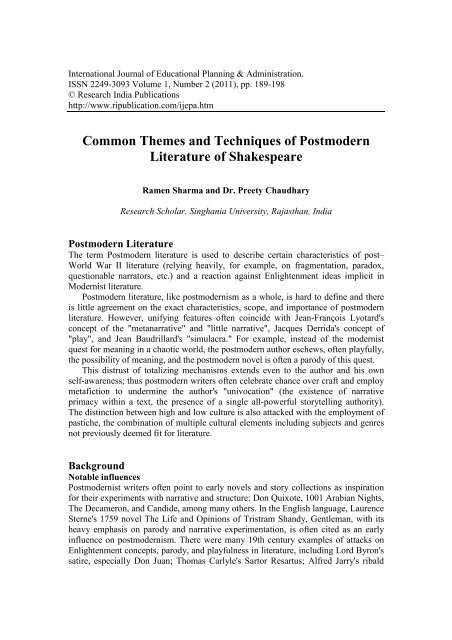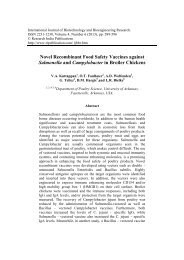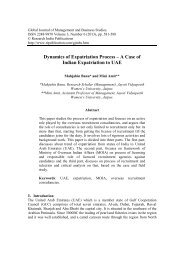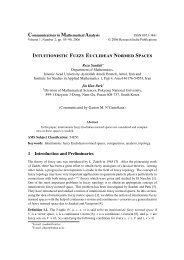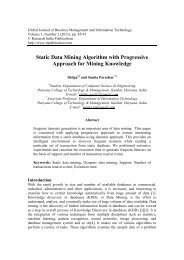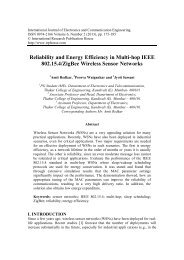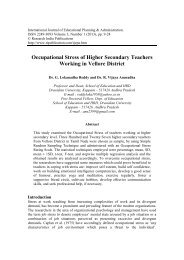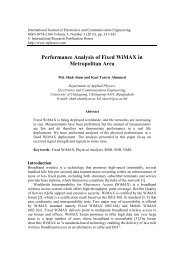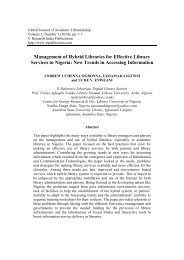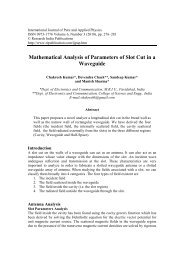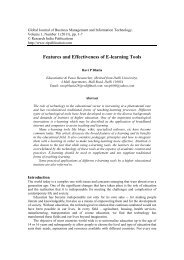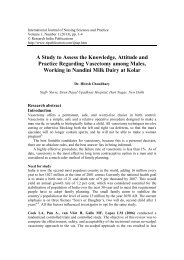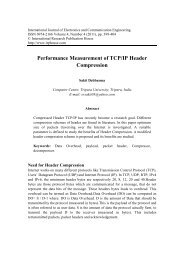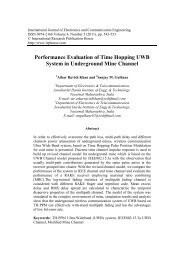Common Themes and Techniques of Postmodern Literature of ...
Common Themes and Techniques of Postmodern Literature of ...
Common Themes and Techniques of Postmodern Literature of ...
Create successful ePaper yourself
Turn your PDF publications into a flip-book with our unique Google optimized e-Paper software.
International Journal <strong>of</strong> Educational Planning & Administration.<br />
ISSN 2249-3093 Volume 1, Number 2 (2011), pp. 189-198<br />
© Research India Publications<br />
http://www.ripublication.com/ijepa.htm<br />
<strong>Common</strong> <strong>Themes</strong> <strong>and</strong> <strong>Techniques</strong> <strong>of</strong> <strong>Postmodern</strong><br />
<strong>Literature</strong> <strong>of</strong> Shakespeare<br />
Ramen Sharma <strong>and</strong> Dr. Preety Chaudhary<br />
Research Scholar, Singhania University, Rajasthan, India<br />
<strong>Postmodern</strong> <strong>Literature</strong><br />
The term <strong>Postmodern</strong> literature is used to describe certain characteristics <strong>of</strong> post–<br />
World War II literature (relying heavily, for example, on fragmentation, paradox,<br />
questionable narrators, etc.) <strong>and</strong> a reaction against Enlightenment ideas implicit in<br />
Modernist literature.<br />
<strong>Postmodern</strong> literature, like postmodernism as a whole, is hard to define <strong>and</strong> there<br />
is little agreement on the exact characteristics, scope, <strong>and</strong> importance <strong>of</strong> postmodern<br />
literature. However, unifying features <strong>of</strong>ten coincide with Jean-François Lyotard's<br />
concept <strong>of</strong> the "metanarrative" <strong>and</strong> "little narrative", Jacques Derrida's concept <strong>of</strong><br />
"play", <strong>and</strong> Jean Baudrillard's "simulacra." For example, instead <strong>of</strong> the modernist<br />
quest for meaning in a chaotic world, the postmodern author eschews, <strong>of</strong>ten playfully,<br />
the possibility <strong>of</strong> meaning, <strong>and</strong> the postmodern novel is <strong>of</strong>ten a parody <strong>of</strong> this quest.<br />
This distrust <strong>of</strong> totalizing mechanisms extends even to the author <strong>and</strong> his own<br />
self-awareness; thus postmodern writers <strong>of</strong>ten celebrate chance over craft <strong>and</strong> employ<br />
metafiction to undermine the author's "univocation" (the existence <strong>of</strong> narrative<br />
primacy within a text, the presence <strong>of</strong> a single all-powerful storytelling authority).<br />
The distinction between high <strong>and</strong> low culture is also attacked with the employment <strong>of</strong><br />
pastiche, the combination <strong>of</strong> multiple cultural elements including subjects <strong>and</strong> genres<br />
not previously deemed fit for literature.<br />
Background<br />
Notable influences<br />
<strong>Postmodern</strong>ist writers <strong>of</strong>ten point to early novels <strong>and</strong> story collections as inspiration<br />
for their experiments with narrative <strong>and</strong> structure: Don Quixote, 1001 Arabian Nights,<br />
The Decameron, <strong>and</strong> C<strong>and</strong>ide, among many others. In the English language, Laurence<br />
Sterne's 1759 novel The Life <strong>and</strong> Opinions <strong>of</strong> Tristram Sh<strong>and</strong>y, Gentleman, with its<br />
heavy emphasis on parody <strong>and</strong> narrative experimentation, is <strong>of</strong>ten cited as an early<br />
influence on postmodernism. There were many 19th century examples <strong>of</strong> attacks on<br />
Enlightenment concepts, parody, <strong>and</strong> playfulness in literature, including Lord Byron's<br />
satire, especially Don Juan; Thomas Carlyle's Sartor Resartus; Alfred Jarry's ribald
190 Ramen Sharma <strong>and</strong> Dr. Preety Chaudhary<br />
Ubu parodies <strong>and</strong> his invention <strong>of</strong> 'Pataphysics; Lewis Carroll's playful experiments<br />
with signification; the work <strong>of</strong> Isidore Ducasse, Arthur Rimbaud, Oscar Wilde.<br />
Playwrights who worked in the late 19th <strong>and</strong> early 20th century whose thought <strong>and</strong><br />
work would serve as an influence on the aesthetic <strong>of</strong> postmodernism include Swedish<br />
dramatist August Strindberg, the Italian author Luigi Pir<strong>and</strong>ello, <strong>and</strong> the German<br />
playwright <strong>and</strong> theorist Bertolt Brecht. In the 1910s, artists associated with Dadaism<br />
celebrated chance, parody, playfulness, <strong>and</strong> attacked the central role <strong>of</strong> the<br />
artist. [clarification needed] Tristan Tzara claimed in "How to Make a Dadaist Poem" that to<br />
create a Dadaist poem one had only to put r<strong>and</strong>om words in a hat <strong>and</strong> pull them out<br />
one by one. Another way Dadaism influenced postmodern literature was in the<br />
development <strong>of</strong> collage, specifically collages using elements from advertisement or<br />
illustrations from popular novels (the collages <strong>of</strong> Max Ernst, for example). Artists<br />
associated with Surrealism, which developed from Dadaism, continued<br />
experimentations with chance <strong>and</strong> parody while celebrating the flow <strong>of</strong> the<br />
subconscious mind. André Breton, the founder <strong>of</strong> Surrealism, suggested that<br />
automatism <strong>and</strong> the description <strong>of</strong> dreams should play a greater role in the creation <strong>of</strong><br />
literature. He used automatism to create his novel Nadja <strong>and</strong> used photographs to<br />
replace description as a parody <strong>of</strong> the overly-descriptive novelists he <strong>of</strong>ten criticized.<br />
Surrealist René Magritte's experiments with signification are used as examples by<br />
Jacques Derrida <strong>and</strong> Michel Foucault. Foucault also uses examples from Jorge Luis<br />
Borges, an important direct influence on many postmodernist fiction writers. He is<br />
occasionally listed as a postmodernist, although he started writing in the 1920s. The<br />
influence <strong>of</strong> his experiments with metafiction <strong>and</strong> magic realism was not fully<br />
realized in the Anglo-American world until the postmodern period. [1]<br />
Comparisons with modernist literature<br />
Both modern <strong>and</strong> postmodern literature represent a break from 19th century realism.<br />
In character development, both modern <strong>and</strong> postmodern literature explore<br />
subjectivism, turning from external reality to examine inner states <strong>of</strong> consciousness,<br />
in many cases drawing on modernist examples in the "stream <strong>of</strong> consciousness" styles<br />
<strong>of</strong> Virginia Woolf <strong>and</strong> James Joyce, or explorative poems like The Waste L<strong>and</strong> by T.<br />
S. Eliot. In addition, both modern <strong>and</strong> postmodern literature explore fragmentariness<br />
in narrative- <strong>and</strong> character-construction. The Waste L<strong>and</strong> is <strong>of</strong>ten cited as a means <strong>of</strong><br />
distinguishing modern <strong>and</strong> postmodern literature. The poem is fragmentary <strong>and</strong><br />
employs pastiche like much postmodern literature, but the speaker in The Waste L<strong>and</strong><br />
says, "these fragments I have shored against my ruins". Modernist literature sees<br />
fragmentation <strong>and</strong> extreme subjectivity as an existential crisis, or Freudian internal<br />
conflict, a problem that must be solved, <strong>and</strong> the artist is <strong>of</strong>ten cited as the one to solve<br />
it. <strong>Postmodern</strong>ists, however, <strong>of</strong>ten demonstrate that this chaos is insurmountable; the<br />
artist is impotent, <strong>and</strong> the only recourse against "ruin" is to play within the chaos.<br />
Playfulness is present in many modernist works (Joyce's Finnegans Wake or Virginia<br />
Woolf's Orl<strong>and</strong>o, for example) <strong>and</strong> they may seem very similar to postmodern works,<br />
but with postmodernism playfulness becomes central <strong>and</strong> the actual achievement <strong>of</strong><br />
order <strong>and</strong> meaning becomes unlikely. [1]
<strong>Common</strong> <strong>Themes</strong> <strong>and</strong> <strong>Techniques</strong> <strong>of</strong> <strong>Postmodern</strong> <strong>Literature</strong> 191<br />
Shift to postmodernism<br />
As with all stylistic eras, no definite dates exist for the rise <strong>and</strong> fall <strong>of</strong><br />
postmodernism's popularity. 1941, the year in which Irish novelist James Joyce <strong>and</strong><br />
English novelist Virginia Woolf both died, is sometimes used as a rough boundary for<br />
postmodernism's start.<br />
The prefix "post", however, does not necessarily imply a new era. Rather, it could<br />
also indicate a reaction against modernism in the wake <strong>of</strong> the Second World War<br />
(with its disrespect for human rights, just confirmed in the Geneva Convention,<br />
through the atomic bombings <strong>of</strong> Hiroshima <strong>and</strong> Nagasaki, the Holocaust, the bombing<br />
<strong>of</strong> Dresden, the fire-bombing <strong>of</strong> Tokyo, <strong>and</strong> Japanese American internment). It could<br />
also imply a reaction to significant post-war events: the beginning <strong>of</strong> the Cold War,<br />
the civil rights movement in the United States, postcolonialism (Postcolonial<br />
literature), <strong>and</strong> the rise <strong>of</strong> the personal computer (Cyberpunk fiction <strong>and</strong> Hypertext<br />
fiction). [2][3][4]<br />
Some further argue that the beginning <strong>of</strong> postmodern literature could be marked<br />
by significant publications or literary events. For example, some mark the beginning<br />
<strong>of</strong> postmodernism with the first publication <strong>of</strong> John Hawkes' The Cannibal in 1949,<br />
the first performance <strong>of</strong> Waiting for Godot in 1953, the first publication <strong>of</strong> Howl in<br />
1956 or <strong>of</strong> Naked Lunch in 1959. For others the beginning is marked by moments in<br />
critical theory: Jacques Derrida's "Structure, Sign, <strong>and</strong> Play" lecture in 1966 or as late<br />
as Ihab Hassan's usage in The Dismemberment <strong>of</strong> Orpheus in 1971. Brian McHale<br />
details his main thesis on this shift, although many postmodern works have developed<br />
out <strong>of</strong> modernism, modernism is characterised by an epistemological dominant while<br />
postmodernism works are primarily concerned with questions <strong>of</strong> ontology. [5]<br />
Post-war developments <strong>and</strong> transition figures<br />
Though postmodernist literature does not refer to everything written in the<br />
postmodern period, several post-war developments in literature (such as the Theatre<br />
<strong>of</strong> the Absurd, the Beat Generation, <strong>and</strong> Magic Realism) have significant similarities.<br />
These developments are occasionally collectively labeled "postmodern"; more<br />
commonly, some key figures (Samuel Beckett, William S. Burroughs, Jorge Luis<br />
Borges, Julio Cortázar <strong>and</strong> Gabriel García Márquez) are cited as significant<br />
contributors to the postmodern aesthetic.<br />
The work <strong>of</strong> Jarry, the Surrealists, Antonin Artaud, Luigi Pir<strong>and</strong>ello <strong>and</strong> so on<br />
also influenced the work <strong>of</strong> playwrights from the Theatre <strong>of</strong> the Absurd. The term<br />
"Theatre <strong>of</strong> the Absurd" was coined by Martin Esslin to describe a tendency in theatre<br />
in the 1950s; he related it to Albert Camus's concept <strong>of</strong> the absurd. The plays <strong>of</strong> the<br />
Theatre <strong>of</strong> the Absurd parallel postmodern fiction in many ways. For example, The<br />
Bald Soprano by Eugène Ionesco is essentially a series <strong>of</strong> clichés taken from a<br />
language textbook. One <strong>of</strong> the most important figures to be categorized as both<br />
Absurdist <strong>and</strong> <strong>Postmodern</strong> is Samuel Beckett. The work <strong>of</strong> Samuel Beckett is <strong>of</strong>ten<br />
seen as marking the shift from modernism to postmodernism in literature. He had<br />
close ties with modernism because <strong>of</strong> his friendship with James Joyce; however, his<br />
work helped shape the development <strong>of</strong> literature away from modernism. Joyce, one <strong>of</strong><br />
the exemplars <strong>of</strong> modernism, celebrated the possibility <strong>of</strong> language; Beckett had a
192 Ramen Sharma <strong>and</strong> Dr. Preety Chaudhary<br />
revelation in 1945 that, in order to escape the shadow <strong>of</strong> Joyce, he must focus on the<br />
poverty <strong>of</strong> language <strong>and</strong> man as a failure. His later work, likewise, featured characters<br />
stuck in inescapable situations attempting impotently to communicate whose only<br />
recourse is to play, to make the best <strong>of</strong> what they have. As Hans-Peter Wagner says,<br />
"Mostly concerned with what he saw as impossibilities in fiction (identity <strong>of</strong><br />
characters; reliable consciousness; the reliability <strong>of</strong> language itself; <strong>and</strong> the<br />
rubrication <strong>of</strong> literature in genres) Beckett's experiments with narrative form <strong>and</strong> with<br />
the disintegration <strong>of</strong> narration <strong>and</strong> character in fiction <strong>and</strong> drama won him the Nobel<br />
Prize for <strong>Literature</strong> in 1969. His works published after 1969 are mostly meta-literary<br />
attempts that must be read in light <strong>of</strong> his own theories <strong>and</strong> previous works <strong>and</strong> the<br />
attempt to deconstruct literary forms <strong>and</strong> genres.[...] Beckett's last text published<br />
during his lifetime, Stirrings Still (1988), breaks down the barriers between drama,<br />
fiction, <strong>and</strong> poetry, with texts <strong>of</strong> the collection being almost entirely composed <strong>of</strong><br />
echoes <strong>and</strong> reiterations <strong>of</strong> his previous work [...] He was definitely one <strong>of</strong> the fathers<br />
<strong>of</strong> the postmodern movement in fiction which has continued undermining the ideas <strong>of</strong><br />
logical coherence in narration, formal plot, regular time sequence, <strong>and</strong><br />
psychologically explained characters." [6]<br />
"The Beat Generation" is a name coined by Jack Kerouac for the disaffected youth<br />
<strong>of</strong> America during the materialistic 1950s; Kerouac developed ideas <strong>of</strong> automatism<br />
into what he called "spontaneous prose" to create a maximalistic, multi-novel epic<br />
called the Duluoz Legend in the mold <strong>of</strong> Marcel Proust's In Search <strong>of</strong> Lost Time.<br />
"Beat Generation" is <strong>of</strong>ten used more broadly to refer to several groups <strong>of</strong> post-war<br />
American writers from the Black Mountain poets, the New York School, the San<br />
Francisco Renaissance, <strong>and</strong> so on. These writers have occasionally also been referred<br />
to as the "<strong>Postmodern</strong>s" (see especially references by Charles Olson <strong>and</strong> the Grove<br />
anthologies edited by Donald Allen). Though this is now a less common usage <strong>of</strong><br />
"postmodern", references to these writers as "postmodernists" still appear <strong>and</strong> many<br />
writers associated with this group (John Ashbery, Richard Brautigan, Gilbert<br />
Sorrentino, <strong>and</strong> so on) appear <strong>of</strong>ten on lists <strong>of</strong> postmodern writers. One writer<br />
associated with the Beat Generation who appears most <strong>of</strong>ten on lists <strong>of</strong> postmodern<br />
writers is William S. Burroughs. Burroughs published Naked Lunch in Paris in 1959<br />
<strong>and</strong> in America in 1961; this is considered by some the first truly postmodern novel<br />
because it is fragmentary, with no central narrative arc; it employs pastiche to fold in<br />
elements from popular genres such as detective fiction <strong>and</strong> science fiction; it's full <strong>of</strong><br />
parody, paradox, <strong>and</strong> playfulness; <strong>and</strong>, according to some accounts, friends Kerouac<br />
<strong>and</strong> Allen Ginsberg edited the book guided by chance. He is also noted, along with<br />
Brion Gysin, for the creation <strong>of</strong> the "cut-up" technique, a technique (similar to Tzara's<br />
"Dadaist Poem") in which words <strong>and</strong> phrases are cut from a newspaper or other<br />
publication <strong>and</strong> rearranged to form a new message. This is the technique he used to<br />
create novels such as Nova Express <strong>and</strong> The Ticket That Exploded.<br />
Magic Realism is a technique popular among Latin American writers (<strong>and</strong> can<br />
also be considered its own genre) in which supernatural elements are treated as<br />
mundane (a famous example being the practical-minded <strong>and</strong> ultimately dismissive<br />
treatment <strong>of</strong> an apparently angelic figure in Gabriel García Márquez's "A Very Old<br />
Man with Enormous Wings"). Though the technique has its roots in traditional
<strong>Common</strong> <strong>Themes</strong> <strong>and</strong> <strong>Techniques</strong> <strong>of</strong> <strong>Postmodern</strong> <strong>Literature</strong> 193<br />
storytelling, it was a center piece <strong>of</strong> the Latin American "boom", a movement<br />
coterminous with postmodernism. Some <strong>of</strong> the major figures <strong>of</strong> the "Boom" <strong>and</strong><br />
practitioners <strong>of</strong> Magic Realism (Gabriel García Márquez, Julio Cortázar etc.) are<br />
sometimes listed as postmodernists. This labeling, however, is not without its<br />
problems. In Spanish-speaking Latin America, modernismo <strong>and</strong> posmodernismo refer<br />
to early 20th-century literary movements that have no direct relationship to<br />
modernism <strong>and</strong> postmodernism in English. Finding it anachronistic, Octavio Paz has<br />
argued that postmodernism is an imported gr<strong>and</strong> récit that is incompatible with the<br />
cultural production <strong>of</strong> Latin America.<br />
Along with Beckett <strong>and</strong> Borges, a commonly cited transitional figure is Vladimir<br />
Nabokov; like Beckett <strong>and</strong> Borges, Nabokov started publishing before the beginning<br />
<strong>of</strong> postmodernity (1926 in Russian, 1941 in English). Though his most famous novel,<br />
Lolita (1955), could be considered a modernist or a postmodernist novel, his later<br />
work (specifically Pale Fire in 1962 <strong>and</strong> Ada or Ardor: A Family Chronicle in 1969)<br />
are more clearly postmodern, see Brian McHale. [7]<br />
<strong>Common</strong> themes <strong>and</strong> techniques<br />
All <strong>of</strong> these themes <strong>and</strong> techniques are <strong>of</strong>ten used together. For example, metafiction<br />
<strong>and</strong> pastiche are <strong>of</strong>ten used for irony. These are not used by all postmodernists, nor is<br />
this an exclusive list <strong>of</strong> features.<br />
Irony, playfulness, black humor<br />
Linda Hutcheon claimed postmodern fiction as a whole could be characterized by the<br />
ironic quote marks, that much <strong>of</strong> it can be taken as tongue-in-cheek. This irony, along<br />
with black humor <strong>and</strong> the general concept <strong>of</strong> "play" (related to Derrida's concept or<br />
the ideas advocated by Rol<strong>and</strong> Barthes in The Pleasure <strong>of</strong> the Text) are among the<br />
most recognizable aspects <strong>of</strong> postmodernism. Though the idea <strong>of</strong> employing these in<br />
literature did not start with the postmodernists (the modernists were <strong>of</strong>ten playful <strong>and</strong><br />
ironic), they became central features in many postmodern works. In fact, several<br />
novelists later to be labeled postmodern were first collectively labeled black<br />
humorists: John Barth, Joseph Heller, William Gaddis, Kurt Vonnegut, Bruce Jay<br />
Friedman, etc. It's common for postmodernists to treat serious subjects in a playful<br />
<strong>and</strong> humorous way: for example, the way Heller, Vonnegut, <strong>and</strong> Pynchon address the<br />
events <strong>of</strong> World War II. A good example <strong>of</strong> postmodern irony <strong>and</strong> black humor is<br />
found in the stories <strong>of</strong> Donald Barthelme; "The School", for example, is about the<br />
ironic death <strong>of</strong> plants, animals, <strong>and</strong> people connected to the children in one class, but<br />
the inexplicable repetition <strong>of</strong> death is treated only as a joke <strong>and</strong> the narrator remains<br />
emotionally distant throughout. The central concept <strong>of</strong> Joseph Heller's Catch-22 is the<br />
irony <strong>of</strong> the now-idiomatic "catch-22", <strong>and</strong> the narrative is structured around a long<br />
series <strong>of</strong> similar ironies. Thomas Pynchon in particular provides prime examples <strong>of</strong><br />
playfulness, <strong>of</strong>ten including silly wordplay, within a serious context. The Crying <strong>of</strong><br />
Lot 49, for example, contains characters named Mike Fallopian <strong>and</strong> Stanley Koteks<br />
<strong>and</strong> a radio station called KCUF, while the novel as a whole has a serious subject <strong>and</strong><br />
a complex structure. [1][10][11]
194 Ramen Sharma <strong>and</strong> Dr. Preety Chaudhary<br />
Intertextuality<br />
Since postmodernism represents a decentered concept <strong>of</strong> the universe in which<br />
individual works are not isolated creations, much <strong>of</strong> the focus in the study <strong>of</strong><br />
postmodern literature is on intertextuality: the relationship between one text (a novel<br />
for example) <strong>and</strong> another or one text within the interwoven fabric <strong>of</strong> literary history.<br />
Critics point to this as an indication <strong>of</strong> postmodernism’s lack <strong>of</strong> originality <strong>and</strong><br />
reliance on clichés. Intertextuality in postmodern literature can be a reference or<br />
parallel to another literary work, an extended discussion <strong>of</strong> a work, or the adoption <strong>of</strong><br />
a style. In postmodern literature this commonly manifests as references to fairy tales –<br />
as in works by Margaret Atwood, Donald Barthelme, <strong>and</strong> many other – or in<br />
references to popular genres such as sci-fi <strong>and</strong> detective fiction. An early 20th century<br />
example <strong>of</strong> intertextuality which influenced later postmodernists is “Pierre Menard,<br />
Author <strong>of</strong> the Quixote” by Jorge Luis Borges, a story with significant references to<br />
Don Quixote which is also a good example <strong>of</strong> intertextuality with its references to<br />
Medieval romances. Don Quixote is a common reference with postmodernists, for<br />
example Kathy Acker's novel Don Quixote: Which Was a Dream. Another example<br />
<strong>of</strong> intertextuality in postmodernism is John Barth’s The Sot-Weed Factor which deals<br />
with Ebenezer Cooke’s poem <strong>of</strong> the same name. Often intertextuality is more<br />
complicated than a single reference to another text. Robert Coover’s Pinocchio in<br />
Venice, for example, links Pinocchio to Thomas Mann’s Death in Venice. Also,<br />
Umberto Eco’s The Name <strong>of</strong> the Rose takes on the form <strong>of</strong> a detective novel <strong>and</strong><br />
makes references to authors such as Aristotle, Arthur Conan Doyle, <strong>and</strong><br />
Borges. [12][13][14]<br />
Pastiche<br />
Related to postmodern intertextuality, pastiche means to combine, or "paste" together,<br />
multiple elements. In <strong>Postmodern</strong>ist literature this can be an homage to or a parody <strong>of</strong><br />
past styles. It can be seen as a representation <strong>of</strong> the chaotic, pluralistic, or<br />
information-drenched aspects <strong>of</strong> postmodern society. It can be a combination <strong>of</strong><br />
multiple genres to create a unique narrative or to comment on situations in<br />
postmodernity: for example, William S. Burroughs uses science fiction, detective<br />
fiction, westerns; Margaret Atwood uses science fiction <strong>and</strong> fairy tales; Umberto Eco<br />
uses detective fiction, fairy tales, <strong>and</strong> science fiction, Derek Pell relies on collage <strong>and</strong><br />
noir detective, erotica, travel guides, <strong>and</strong> how-to manuals, <strong>and</strong> so on. Though pastiche<br />
commonly refers to the mixing <strong>of</strong> genres, many other elements are also included<br />
(metafiction <strong>and</strong> temporal distortion are common in the broader pastiche <strong>of</strong> the<br />
postmodern novel). For example, Thomas Pynchon includes in his novels elements<br />
from detective fiction, science fiction, <strong>and</strong> war fiction; songs; pop culture references;<br />
well-known, obscure, <strong>and</strong> fictional history mixed together; real contemporary <strong>and</strong><br />
historical figures (Mickey Rooney <strong>and</strong> Wernher von Braun for example); a wide<br />
variety <strong>of</strong> well-known, obscure <strong>and</strong> fictional cultures <strong>and</strong> concepts. In Robert<br />
Coover's 1977 novel The Public Burning, Coover mixes historically inaccurate<br />
accounts <strong>of</strong> Richard Nixon interacting with historical figures <strong>and</strong> fictional characters<br />
such as Uncle Sam <strong>and</strong> Betty Crocker. Pastiche can also refer to compositional<br />
technique, for example the cut-up technique employed by Burroughs. Another
<strong>Common</strong> <strong>Themes</strong> <strong>and</strong> <strong>Techniques</strong> <strong>of</strong> <strong>Postmodern</strong> <strong>Literature</strong> 195<br />
example is B. S. Johnson's 1969 novel The Unfortunates; it was released in a box with<br />
no binding so that readers could assemble it however they chose. [1][15][16]<br />
Metafiction<br />
Metafiction is essentially writing about writing or "foregrounding the apparatus",<br />
making the artificiality <strong>of</strong> art or the fictionality <strong>of</strong> fiction apparent to the reader <strong>and</strong><br />
generally disregards the necessity for "willful suspension <strong>of</strong> disbelief". It is <strong>of</strong>ten<br />
employed to undermine the authority <strong>of</strong> the author, for unexpected narrative shifts, to<br />
advance a story in a unique way, for emotional distance, or to comment on the act <strong>of</strong><br />
storytelling. For example, Italo Calvino's 1979 novel If on a winter's night a traveler is<br />
about a reader attempting to read a novel <strong>of</strong> the same name. Kurt Vonnegut also<br />
commonly used this technique: the first chapter <strong>of</strong> his 1969 novel Slaughterhouse-<br />
Five is about the process <strong>of</strong> writing the novel <strong>and</strong> calls attention to his own presence<br />
throughout the novel. Though much <strong>of</strong> the novel has to do with Vonnegut's own<br />
experiences during the firebombing <strong>of</strong> Dresden, Vonnegut continually points out the<br />
artificiality <strong>of</strong> the central narrative arc which contains obviously fictional elements<br />
such as aliens <strong>and</strong> time travel. Similarly, Tim O'Brien's 1990 novel/story collection<br />
The Things They Carried, about one platoon's experiences during the Vietnam War,<br />
features a character named Tim O'Brien; though O'Brien was a Vietnam veteran, the<br />
book is a work <strong>of</strong> fiction <strong>and</strong> O'Brien calls into question the fictionality <strong>of</strong> the<br />
characters <strong>and</strong> incidents through out the book. One story in the book, "How to Tell a<br />
True War Story", questions the nature <strong>of</strong> telling stories. Factual retellings <strong>of</strong> war<br />
stories, the narrator says, would be unbelievable <strong>and</strong> heroic, moral war stories don't<br />
capture the truth.<br />
Fabulation<br />
Fabulation is a term sometimes used interchangeably with metafiction <strong>and</strong> relates to<br />
pastiche <strong>and</strong> Magic Realism. It is a rejection <strong>of</strong> realism which embraces the notion<br />
that literature is a created work <strong>and</strong> not bound by notions <strong>of</strong> mimesis <strong>and</strong><br />
verisimilitude. Thus, fabulation challenges some traditional notions <strong>of</strong> literature—the<br />
traditional structure <strong>of</strong> a novel or role <strong>of</strong> the narrator, for example—<strong>and</strong> integrates<br />
other traditional notions <strong>of</strong> storytelling, including fantastical elements, such as magic<br />
<strong>and</strong> myth, or elements from popular genres such as science fiction. By some accounts,<br />
the term was coined by Robert Scholes in his book The Fabulators. A good example<br />
<strong>of</strong> fabulation is Salman Rushdie´s Haroun <strong>and</strong> the Sea <strong>of</strong> Stories. [17]<br />
Poioumena<br />
Poioumenon (plural: poioumena; from Ancient Greek: ποιούμενον, "product") is a<br />
term coined by Alastair Fowler to refer to a specific type <strong>of</strong> metafiction in which the<br />
story is about the process <strong>of</strong> creation. According to Fowler, "the poioumenon is<br />
calculated to <strong>of</strong>fer opportunities to explore the boundaries <strong>of</strong> fiction <strong>and</strong> reality—the<br />
limits <strong>of</strong> narrative truth." [18] In many cases, the book will be about the process <strong>of</strong><br />
creating the book or includes a central metaphor for this process. <strong>Common</strong> examples<br />
<strong>of</strong> this Thomas Carlyle's Sartor Resartus <strong>and</strong> Laurence Sterne's Tristram Sh<strong>and</strong>y<br />
which is about the narrator's frustrated attempt to tell his own story. A significant
196 Ramen Sharma <strong>and</strong> Dr. Preety Chaudhary<br />
postmodern example is Vladimir Nabokov's Pale Fire, in which the narrator, Kinbote,<br />
claims he is writing an analysis <strong>of</strong> John Shade's long poem "Pale Fire", but the<br />
narrative <strong>of</strong> the relationship between Shade <strong>and</strong> Kinbote is presented in what is<br />
ostensibly the footnotes to the poem. Similarly, the self-conscious narrator in Salman<br />
Rushdie's Midnight's Children parallels the creation <strong>of</strong> his book to the creation <strong>of</strong><br />
chutney <strong>and</strong> the creation <strong>of</strong> independent India. Other postmodern examples <strong>of</strong><br />
poioumena include Samuel Beckett's trilogy (Molloy, Malone Dies <strong>and</strong> The<br />
Unnamable); Doris Lessing's The Golden Notebook; John Fowles's Mantissa; William<br />
Golding's Paper Men; <strong>and</strong> Gilbert Sorrentino's Mulligan Stew. [14][18][19][20][21]<br />
Historiographic metafiction<br />
Linda Hutcheon coined the term "historiographic metafiction" to refer to works that<br />
fictionalize actual historical events or figures; notable examples include The General<br />
in His Labyrinth by Gabriel García Márquez (about Simón Bolívar), Flaubert's Parrot<br />
by Julian Barnes (about Gustave Flaubert), Ragtime by E. L. Doctorow (which<br />
features such historical figures as Harry Houdini, Henry Ford, Archduke Franz<br />
Ferdin<strong>and</strong> <strong>of</strong> Austria, Booker T. Washington, Sigmund Freud, Carl Jung), <strong>and</strong> Rabih<br />
Alameddine's Koolaids: The Art <strong>of</strong> War which makes references to the Lebanese<br />
Civil War <strong>and</strong> various real life political figures. Thomas Pynchon's Mason <strong>and</strong> Dixon<br />
also employs this concept; for example, a scene featuring George Washington<br />
smoking marijuana is included. John Fowles deals similarly with the Victorian Period<br />
in The French Lieutenant's Woman. In regards to critical theory, this technique can be<br />
related to The Death <strong>of</strong> the Author by Rol<strong>and</strong> Barthes. [1]<br />
Temporal distortion<br />
This is a common technique in modernist fiction: fragmentation <strong>and</strong> non-linear<br />
narratives are central features in both modern <strong>and</strong> postmodern literature. Temporal<br />
distortion in postmodern fiction is used in a variety <strong>of</strong> ways, <strong>of</strong>ten for the sake <strong>of</strong><br />
irony. Historiographic metafiction (see above) is an example <strong>of</strong> this. Distortions in<br />
time are central features in many <strong>of</strong> Kurt Vonnegut's non-linear novels, the most<br />
famous <strong>of</strong> which is perhaps Billy Pilgrim in Slaughterhouse-Five becoming "unstuck<br />
in time". In Flight to Canada, Ishmael Reed deals playfully with anachronisms,<br />
Abraham Lincoln using a telephone for example. Time may also overlap, repeat, or<br />
bifurcate into multiple possibilities. For example, in Robert Coover's "The Babysitter"<br />
from Pricksongs & Descants, the author presents multiple possible events occurring<br />
simultaneously—in one section the babysitter is murdered while in another section<br />
nothing happens <strong>and</strong> so on—yet no version <strong>of</strong> the story is favored as the correct<br />
version. [1]<br />
Magic realism<br />
Literary work marked by the use <strong>of</strong> still, sharply defined, smoothly painted images <strong>of</strong><br />
figures <strong>and</strong> objects depicted in a surrealistic manner. The themes <strong>and</strong> subjects are<br />
<strong>of</strong>ten imaginary, somewhat outl<strong>and</strong>ish <strong>and</strong> fantastic <strong>and</strong> with a certain dream-like<br />
quality. Some <strong>of</strong> the characteristic features <strong>of</strong> this kind <strong>of</strong> fiction are the mingling <strong>and</strong><br />
juxtaposition <strong>of</strong> the realistic <strong>and</strong> the fantastic or bizarre, skillful time shifts,
<strong>Common</strong> <strong>Themes</strong> <strong>and</strong> <strong>Techniques</strong> <strong>of</strong> <strong>Postmodern</strong> <strong>Literature</strong> 197<br />
convoluted <strong>and</strong> even labyrinthine narratives <strong>and</strong> plots, miscellaneous use <strong>of</strong> dreams,<br />
myths <strong>and</strong> fairy stories, expressionistic <strong>and</strong> even surrealistic description, arcane<br />
erudition, the element <strong>of</strong> surprise or abrupt shock, the horrific <strong>and</strong> the inexplicable. It<br />
has been applied, for instance, to the work <strong>of</strong> Jorge Luis Borges, the Argentinian who<br />
in 1935 published his Historia universal de la infamia, regarded by many as the first<br />
work <strong>of</strong> magic realism. Colombian novelist Gabriel García Marquez is also regarded<br />
as a notable exponent <strong>of</strong> this kind <strong>of</strong> fiction – especially his novel One Hundred Years<br />
<strong>of</strong> Solitude. The Cuban Alejo Carpentier is another described as a "magic realist".<br />
<strong>Postmodern</strong>ists such as Salman Rushdie <strong>and</strong> Italo Calvino commonly use Magic<br />
Realism in their work. [1][14] A fusion <strong>of</strong> fabulism with magic realism is apparent in<br />
such early 21st century American short stories as Kevin Brockmeier's "The Ceiling",<br />
Technoculture <strong>and</strong> hyperreality<br />
Fredric Jameson called postmodernism the "cultural logic <strong>of</strong> late capitalism". "Late<br />
capitalism" implies that society has moved past the industrial age <strong>and</strong> into the<br />
information age. Likewise, Jean Baudrillard claimed postmodernity was defined by a<br />
shift into hyperreality in which simulations have replaced the real. In postmodernity<br />
people are inundated with information, technology has become a central focus in<br />
many lives, <strong>and</strong> our underst<strong>and</strong>ing <strong>of</strong> the real is mediated by simulations <strong>of</strong> the real.<br />
Many works <strong>of</strong> fiction have dealt with this aspect <strong>of</strong> postmodernity with characteristic<br />
irony <strong>and</strong> pastiche. For example, Don DeLillo's White Noise presents characters who<br />
are bombarded with a "white noise" <strong>of</strong> television, product br<strong>and</strong> names, <strong>and</strong> clichés.<br />
The cyberpunk fiction <strong>of</strong> William Gibson, Neal Stephenson, <strong>and</strong> many others use<br />
science fiction techniques to address this postmodern, hyperreal information<br />
bombardment. [23][24][25] Steampunk, a subgenre <strong>of</strong> science fiction popularized in<br />
novels <strong>and</strong> comics by such writers as Alan Moore <strong>and</strong> James Blaylock, demonstrates<br />
postmodern pastiche, temporal distortion, <strong>and</strong> a focus on technoculture with its mix <strong>of</strong><br />
futuristic technology <strong>and</strong> Victorian culture.<br />
Paranoia<br />
Perhaps demonstrated most famously <strong>and</strong> effectively in Joseph Heller's Catch-22 <strong>and</strong><br />
the work <strong>of</strong> Thomas Pynchon, the sense <strong>of</strong> paranoia, the belief that there's an ordering<br />
system behind the chaos <strong>of</strong> the world is another recurring postmodern theme. For the<br />
postmodernist, no ordering system exists, so a search for order is fruitless <strong>and</strong> absurd.<br />
The Crying <strong>of</strong> Lot 49 by Thomas Pynchon has many possible interpretations. [26] This<br />
<strong>of</strong>ten coincides with the theme <strong>of</strong> technoculture <strong>and</strong> hyperreality. For example, in<br />
Breakfast <strong>of</strong> Champions by Kurt Vonnegut, the character Dwayne Hoover becomes<br />
violent when he's convinced that everyone else in the world is a robot <strong>and</strong> he is the<br />
only human. [1]<br />
Maximalism<br />
Dubbed maximalism by some critics, the sprawling canvas <strong>and</strong> fragmented narrative<br />
<strong>of</strong> such writers as Dave Eggers has generated controversy on the "purpose" <strong>of</strong> a novel<br />
as narrative <strong>and</strong> the st<strong>and</strong>ards by which it should be judged. The postmodern position<br />
is that the style <strong>of</strong> a novel must be appropriate to what it depicts <strong>and</strong> represents, <strong>and</strong>
198 Ramen Sharma <strong>and</strong> Dr. Preety Chaudhary<br />
points back to such examples in previous ages as Gargantua by François Rabelais <strong>and</strong><br />
the Odyssey <strong>of</strong> Homer, which Nancy Felson hails as the exemplar <strong>of</strong> the polytropic<br />
audience <strong>and</strong> its engagement with a work.<br />
Many modernist critics, notably B.R. Myers in his polemic A Reader's Manifesto,<br />
attack the maximalist novel as being disorganized, sterile <strong>and</strong> filled with language<br />
play for its own sake, empty <strong>of</strong> emotional commitment—<strong>and</strong> therefore empty <strong>of</strong> value<br />
as a novel. Yet there are counter-examples, such as Pynchon's Mason & Dixon <strong>and</strong><br />
Minimalism<br />
Literary minimalism can be characterized as a focus on a surface description where<br />
readers are expected to take an active role in the creation <strong>of</strong> a story. The characters in<br />
minimalist stories <strong>and</strong> novels tend to be unexceptional. Generally, the short stories are<br />
"slice <strong>of</strong> life" stories. Minimalism, the opposite <strong>of</strong> maximalism, is a representation <strong>of</strong><br />
only the most basic <strong>and</strong> necessary pieces, specific by economy with words.<br />
Minimalist authors hesitate to use adjectives, adverbs, or meaningless details. Instead<br />
<strong>of</strong> providing every minute detail, the author provides a general context <strong>and</strong> then<br />
allows the reader's imagination to shape the story. Among those categorized as<br />
postmodernist, literary minimalism is most commonly associated with Samuel<br />
Beckett.<br />
References<br />
[1] Oruch, Jack B., "St. Valentine, Chaucer, <strong>and</strong> Spring in February," Speculum,<br />
56 (1981): 534–65. Oruch's survey <strong>of</strong> the literature finds no association<br />
between Valentine <strong>and</strong> romance prior to Chaucer. He concludes that Chaucer is<br />
likely to be "the original mythmaker in this instance." Colfa.utsa.edu<br />
[2] http://www.morrissociety.org/JWMS/SP94.10.4.Nichols.pdf<br />
[3] Thomas Weber, "G<strong>and</strong>hi as Disciple <strong>and</strong> Mentor," Cambridge University Press,<br />
2004, pp. 28–29.<br />
[4] David, Deirdre The Cambridge companion to the Victorian novel p.179.<br />
Cambridge University Press, 2001.<br />
[5] Elleke Boehmer (2008). Nelson M<strong>and</strong>ela: a very short introduction. p. 157.<br />
Oxford University Press, 2008. "'Invictus', taken on its own, M<strong>and</strong>ela clearly<br />
found his Victorian ethic <strong>of</strong> self-mastery"<br />
[6] Beebe, Maurice (Fall 1972). "Ulysses <strong>and</strong> the Age <strong>of</strong> Modernism". James Joyce<br />
Quarterly (University <strong>of</strong> Tulsa) 10 (1): p. 176.<br />
[7] The Cambridge companion to Virginia Woolf. By Sue Roe, Susan Sellers.<br />
p.219. Cambridge University Press, 2000.<br />
[8] Elmes, Simon (2005) Talking for Britain: a journey through the nation's<br />
dialects . London: Penguin Books (Word 4 word: the voices survey \ BBC).<br />
[9] Penn, Stephen (2005) “Literacy <strong>and</strong> Literary Production” in Chaucer: an<br />
Oxford guide, ed. Ellis, Steve (New York: Oxford University Press, 2005), pp.<br />
113-130<br />
[10] Caxton's Chaucer - Caxton's English


